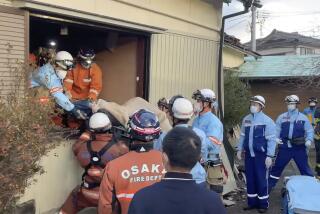Plutonium from Japan nuclear disaster not seen as major threat
The levels of radioactive plutonium around the Fukushima Daiichi nuclear power plant aren’t much higher than the amount of plutonium remaining in the environment from Cold War-era nuclear weapons tests, and it probably poses little threat to humans, a new study indicates.
The paper, published Thursday in the journal Scientific Reports, examines the area within a roughly 20-mile radius of the stricken plant and details the concentration of plutonium isotopes deposited there after explosions ripped open multiple reactors. At the three sites examined, the levels were about double those attributed to residual fallout from above-ground nuclear tests conducted by the U.S. and former Soviet Union at the dawn of the Cold War.
The study comes days before the anniversary of the magnitude 9 earthquake and resulting tsunami last year that devastated northeastern Japan, leaving more than 27,000 people dead or missing and billions of dollars in damage. Experts in nuclear safety and disaster preparedness are using the occasion to weigh in with reports detailing the lessons learned in the last year.
In the area around the Fukushima plant, preliminary testing hadn’t turned up signs of new plutonium isotopes in the soil. Unlike cesium-137 and other radioactive isotopes, plutonium can’t vaporize and travel through the air. But it’s possible the force of the hydrogen explosions blew out a little plutonium in the form of particulate matter.
Plutonium isotopes can’t pass through skin, but if ingested, they can be very damaging to humans.
Lead author Jian Zheng of the National Institute of Radiological Sciences in Chiba, Japan, and his colleagues analyzed soil samples looking for several different plutonium isotopes that are produced during the course of the power plants’ nuclear reactions. Plutonium-241, for example, has a half-life of about 14 years, which means that it takes 14 years for half of it to decay into other elements. But plutonium-239 has a half-life of 24,100 years, so it takes much longer to disappear.
Since the weapons tests that produced the global background radiation began in the 1940s, the amount of plutonium-241 that can be traced to them should be low in comparison to the amount of residual plutonium-239. But near Fukushima, the researchers found that the ratio of plutonium-241 to plutonium-239 was much higher than expected. They said it was a clear sign that fresh plutonium must have been deposited in the area.
According to Zheng, the total amount of plutonium-241 released from the power plant was about 10,000 times less than that from the 1986 Chernobyl accident in Ukraine.
“It’s an interesting detective story,” said Michael Ketterer, a scientist at Northern Arizona University who has studied Chernobyl radiation but was not involved in this study. “I find the results to be fairly convincing.”
Robert Alvarez, who has served as a senior policy advisor in the U.S. Energy Department, said he would have been surprised if researchers had not found evidence of plutonium contamination near the plant. “They were irradiating plutonium in Unit 3, which experienced the biggest explosion.”
In fact, the explosion was so massive that investigators found fuel rod fragments a mile away, leading to speculation that a supercritical fission event may have also occurred, Alvarez said.
Still, “Fukushima was no Chernobyl,” said Dale Klein, a former Nuclear Regulatory Commission chairman and coauthor of a report on Fukushima for the American Nuclear Society. That report says the long-term health risks of the radioactive fallout probably would be minimal.
The nuclear society’s paper also looked at the mechanical and human errors that contributed to the partial nuclear meltdown. The authors determined that the plant’s design had not accounted for the risks of the region. On the most basic level, the 19-foot-high seawall had not been designed to withstand the tsunami, at points 49 feet high.
NRC Commissioner William Ostendorff agreed, noting that the tsunami wiped out the plant’s power systems, initiating a grim domino effect.
With no energy to pump coolant to them, the reactors overheated. When the nuclear fuel’s protective zirconium alloy encasement heated up and came into contact with water, the zirconium oxidized and released the hydrogen gas that ultimately exploded, allowing radioactive elements to escape.
The chain reaction highlighted the need for a foolproof power system that would allow workers to pump in cooling water and operate valves that would have relieved pressure from the accumulating hydrogen gas.
In terms of building safer nuclear reactors, Ostendorff said, “I think we have quite a bit of information right now … to make regulatory decisions.”
But Alvarez said that much remains unknown one year after the disaster. Authorities can’t say exactly where breaches occurred in the reactor vessels and spent fuel pools that caused contaminated water to flood the plant’s lower levels, he said.
The Japanese asserted that they had achieved a “cold shutdown” of the Fukushima site in December, but they will require a stable and permanent infrastructure to keep the situation under control. It is possible, and even likely, that radioactive cooling water is still leaking into the Pacific Ocean, Alvarez said. Cleanup of the immediate site could take four or five decades, he said.
Times staff writer Ralph Vartabedian contributed to this report.







